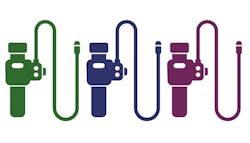As the billowing smoke clears from the roiling emergence of disposable/single-use-only endoscopes, Sterile Processing & Distribution executives and leaders are beginning to see some clarity on endoscopic product market shifts as the future comes into focus.
From an armchair investor standpoint, their advice seems to line up this way:
1. Don’t invest in reusable endoscope growth, but don’t totally dump all your stock in it.
2. Don’t bet your entire fortune on disposable/single-use-only domination just yet, but certainly bolster your portfolio.
3. Look for the future to be somewhere in between the previous two extremes as the market and SDP behaviors will find balance between moving back and forth rather slowly.
Healthcare Purchasing News continues to explore the emergence of disposable/single-use-only endoscopic devices that currently are making some headway in terms of generating interest and gaining customers. Just a few years ago, the Surgical Services and SPD market segments had disposable/single-use endoscopic devices on their wish lists as the products remained in development. They’re here now.
And rather than keeping these new products at arm’s length, SPD executives and leaders fully acknowledge they’re here to stay, but SPD likely shouldn’t be concerned that their future in reprocessing reusable devices is in jeopardy.
HPN reached out to a small group of executives at manufacturers of endoscope devices and related reprocessing supplies and equipment about their changing forecast of any market shifts during the next 10 to 14 years through 2035. They were able to choose from among five different potential market scenarios and to share their reasoning.
1. Fully reusable endoscopes will remain. Healthcare organizations will continue to rely on fully reusable flexible and rigid endoscopes for the majority of minimally invasive surgical (MIS) procedures
2. Hybrid models will become a minority segment. Healthcare organizations will increasingly shift toward using hybrid flexible and rigid endoscopes that incorporate disposable components that can be discarded after use, but the hybrid models WILL NOT surpass the use of fully reusable models
3. Hybrid models will become the majority. Healthcare organizations will increasingly shift toward using hybrid flexible and rigid endoscopes that incorporate disposable components that can be discarded after use, and the hybrid models WILL surpass the use of fully reusable models
4. Disposable/single-use only models will become a minority segment. Healthcare organizations will increasingly shift toward using fully disposable flexible and rigid endoscopes, but the disposable models WILL NOT surpass the use of fully reusable models
5. Disposable/single-use only models will become the majority. Healthcare organizations will increasingly shift toward using fully disposable flexible and rigid endoscopes, and the disposable models WILL surpass the use of fully reusable models
Move to the middle
Experts remain steadfast and unmovable in their opinions that the two “fringe” elements – Nos. 1 and 5 – likely will not happen. They believe the market will not sustain the use of only reusable endoscopes for surgical procedures. At the same time, they also argue the market will not shift totally to disposable/single-use models either, nor will these models surpass or overwhelm the use of reusables.
Several, however, anticipate a growing shift toward use of disposable/single-use endoscopes for an increasing number of surgical procedures but they will not surpass the use of fully reusable models.
“Continuing outbreaks associated with all flexible and rigid endoscopes dictate that there is a device-related contamination issue that transcends medical disciplines,” concluded J. Hudson Garrett Jr. PhD, MSN, MPH, MBA, FNP-BC, CPHQ, PLNC, AS-BC, IP-BC, VA-BC, CFER, CPPS, CDONA, DICO-C, GDCN, NREMT, NCEE, FACDONA, TR-C, FAAPM, FNAP, FSHEA, Adjunct Assistant Professor, Division of Infectious Diseases, Department of Medicine, Center for Education and Training in Infection Prevention, University of Louisville School of Medicine. “As such, there must be a shift from using the exact devices that the data shows cause infection outbreaks and move to a more suitable platform of sterile, single-use endoscopes that completely eliminate the need for reprocessing. Eliminating this risky process is the highest possible level of infection control intervention.”
Melinda “Mindy” Benedict, CIC, CFER, Global Senior Manager, Infection Prevention, Olympus Corporation of the Americas, concurs to an extent and with caveats.
“Single-use endoscopes will surpass reusables in some specialty areas, but adoption will be different for different patient populations, different physician preferences and different facilities,” she said. “The medical waste and cost challenges will need to be addressed.”
Hybrids stake shallow claim
The majority of sterile processing subject matter experts remain solidly behind so-called hybrid model endoscopes, which are reusable devices that incorporate disposable/single-use components that can be discarded after use. And while this group foresees hybrids gaining in popularity, they are split right down the middle on whether they will overtake the use of fully reusable devices.
“I do not see disposable rigid endoscopes taking over their reusable counterparts,” said Melissa Kubach, Clinical Education and Training Manager, National Solutions Team, Agiliti. “Disposable rigids have been tried in the past, but adoption was minimal due to problems with image and lighting quality, and those devices ended up being cost prohibitive. Without addressing those issues, I believe the industry will stay with the current rigid equipment.
“Incorporation of hybrid flexible endoscopes with disposable components will increase,” she observed, “especially for procedures with elevated risk. This is further supported by the current [Centers for Disease Control and Prevention] recommendations.”
Kubach predicts fully disposable models to be reserved for specialized functions.
“Employing fully disposable flexible endoscopes has and will continue to increase for certain procedures and specialties such as airway management, including some bronchoscopy,” she noted. “Currently, this has been highly based on emergency use or convenience, such as after-hour or weekend use, when cleaning staff are not readily available. Disposable ‘back-up’ inventories have also increased for high-volume Anesthesia departments. Another area benefiting from disposable-use based on need is Urology. Fast-paced patient turnover and the delicate nature specific to small diameter flexible ureteroscopes has created a niche.”
Kubach sees certain endoscope types not yet fully ready for disposable prime time.
“Standard large diameter flexible endoscopes will be slow to jump the disposable threshold,” she indicated. “Reimbursement, or the lack thereof, is key. Further speedbumps are related to current reusable high-definition image quality and the ‘feel’ of the endoscope itself. Physicians will be slow to relinquish high resolution and technological features such as anatomical positioning and enhancements from narrow band lighting, spectral imaging or blue and white light features.”
Weighing the pros and cons of using primarily reusable models indicates that the rise of hybrid models seems inevitable, according to Shaun Sweeney, Vice President, Cygnus Medical.
“The current reusable scope image quality and construction clearly offer the doctor greater control, which leads to greater patient care,” Sweeney said. “The industry is constantly improving cleaning techniques at each of the cleaning stages, but there are some challenges that remain. Focusing on the problem areas, such as using disposable components of ERCP elevator mechanisms, has already begun. Disposable valves have been very successful in making this transition.
“The infection control benefits of a 100% disposable scope does not outweigh the benefits of the performance quality of current reusable scopes,” he continued. “Having had an 8-track player in my first car, I have come to realize how hard it is to see how dramatically things can change overnight. Likely, 20 years from now, there will be an exponential technology shift that has not even raised its head in today’s market. I think the best strategy today is to constantly be looking for incremental improvements until that time comes.”
John Whelan, RN, Clinical Education Specialist, Healthmark Industries, casts his impressions in context of the previously unforeseen circumstances from the COVID-19 pandemic.
“Who could have foreseen the global semiconductor shortage that has crippled availability for new vehicles?” he asked. “Also using the automobile analogy, the cost of hybrid and fully alternative (for endoscopes, read as fully disposable) technology is prohibitive for many facilities to consider. I believe even 15 to 20 years out, purchase/lease decisions [for] flexible endoscopes will still be considerably influenced by purchase/supply costs, and less so by sustainability (i.e., recycling) considerations.”
Because healthcare institutions are layered organizations, change happens slowly, according to Whelan. “Until or unless governmental direction is even more prescriptive, and/or full facility reimbursement for single-use endoscopes is guaranteed across-the-board, reusable endoscopes will still be in use,” he said. “What I do believe will change more over the next several years is technological advances in the automated cleaning, disinfection and sterilization for reusable devices – including flexible endoscopes. Research and development continue underway to bring such changes to the market, and with a goal of affordable implementation.”
Gregg Agoston, Vice President, Business Development, SPD Transformation Services, SpecialtyCare, expects the market will shift to help solve current problems.
“To this end, hybrid products will play a role and to the end that the product changes provide economic and safety benefits that outweigh current products, they will be accepted,” Agoston indicated. “Often with flexible endoscopes, they are the singular product used in the procedure, thus it is relatively easy to identify the endoscope as the cause of an infection when this occurs.
“In the majority of other [surgical site infections] it is not so easy,” he continued. “Was it the rigid endoscope, the shaver, the [minimally invasive surgery] hand instrument, the failure of the nurse to properly prep the patient, or the patient intrinsic factors that lead to the infection? My point being that if we are moving to more costly or waste-producing products because we are fearful that the SPD staff cannot properly clean them, then we should do this for all surgical procedures that use complex instruments because all can cause infection.
“We know that the SSI rates as of the last report were the only category of [healthcare-associated infections] that did not show a decrease,” he said. “We also know that SSI are only tracked for a certain few procedure types, thus the true number of SSI is much higher than reported. At a recent meeting for OR business managers I asked the audience how many had had or had a close relative or friend acquire an SSI and three-fourths of the audience raised their hand. The solution should be focused on product improvements to make them easier to process, process improvements to automate as much as possible and staffing improvements recognizing the importance of a well-trained, stable staff of professionals whose role it is to process complex instruments.”
Hybrids go deep
Some may not believe hybrids will progress so far as to be used by the majority, but others certainly do.
“The most important things that will be considered are budget, Infection rates, and material quality,” said Jamie Zarembinski CCSVP, CER, Clinical Educator – Sterile Processing, Key Surgical, a STERIS company. “If the cost of a hybrid or disposable scope is comparable to the cost of reprocessing a reusable scope, it will increase their use. Further, if hybrid/disposables decrease infection risk, the industry trend will undoubtedly support the transition to hybrid/disposables. Finally, the material quality and complex video components in each type of scope will influence choice.
“One of the current hot topics causing hesitation to transition to hybrid/disposable scopes is image quality,” she said. “If surgeons are unable to properly visualize, diagnose and treat related to scope image issues, the industry is going to stick with reusables. There is a lot of pressure on manufacturers of all types of scopes to optimize outcomes in all three of these areas – budget, infection rate reduction, and quality, but this pressure will ultimately lead to greater patient outcomes.”
For Ron Banach, Director of Clinical Education, Ruhof Inc., economics and image quality will drive migration.
“The cost of the disposables will limit the full integration of disposable flexible and rigid endoscopes unless the insurance companies adjust their procedure reimbursement rates to include the additional cost for the disposables devices, and the manufacturers can equal or exceed the physicians demands for diagnostic quality,” he said.
Sterile Processing technicians have had to endure the cleaning challenges with complex reusable medical devices like flexible, semi-rigid, and rigid endoscopes, according to Cheron Rojo, CHL, CIS, CER, CFER, CRCST, Clinical Education Specialist, Healthmark Industries.
“With the implementation in recent years of a disposable tip for some of the vendors of duodenoscopes the change has made a positive difference for sterile processing professionals regarding cleaning, but there is still room to expand without altering the feel or function of the medical device for the surgeon or proceduralist,” Rojo said.
“Hybrid [models] with both reusable and disposable sections save money and the environment instead of a full disposable medical device that can be costly to the patient and add to the landfill, especially in states with clean initiatives like California, Hawaii, etc.,” he said. ‘Further development still needs to take place to think outside the box to provide hybrids in semi-rigid and rigid endoscopes that meet surgeon, sterile processing and healthcare facility’s needs; and most of all, provide a functional, clean, and safe medical device for patients.”
Jean Sargent, Principal, Sargent Healthcare Strategies, and a former Supply Chain and SPD director, offers a curious perspective that hearkens to the bottom line.
“For me personally, I am hoping hybrid models will be a back up to reusables,” she said. “However, in dealing with requests from physicians for disposable or hybrid scopes for convenience, we are overlooking the root cause. Is the root cause staffing? Proximity to processing facilities? Not enough reusable scopes? Once a root cause analysis is completed, determine what needs to be done to address the need. It may be reusable/hybrids or it may be staff or updated processes. Each and every organization is different and should look at the need from all three viewpoints when determining a strategic direction for these products.”
Continue reading …
Pre-treatment at point-of-use ‘whodunit’
Pre-treating short cuts, task shifts can breed danger for patients
What does SPD need for endoscope reprocessing quality
All hail to the hybrids by the mid-2030s
Don’t let hang-time become a hang-up
Quality sterile processing a step-by-step process that starts in surgery
Dawn of the disposables domination
Or maybe that dream is single-use only vs. sustainable?
Sterile Processing & Distribution (SPD) executives and leaders with special expertise in endoscopic devices may envision a future flush with hybrid products that represent the optimal answer to the reusable vs. disposable debate.
But do they ever anticipate disposable/single-use rigid and/or flexible endoscopes emerging as the preference used by the majority of surgeons and healthcare organizations? Maybe. Maybe not.
“In the long term, I think this is very much a possible reality to reduce the risk to patients and to improve clinical through-put of clinical procedures. There are two critical determining factors that will likely drive this transition: Clinical device performance and functionality and price. The single-use devices must perform the same or better as reusable devices and the single-use devices must be economically priced to encourage use. In addition, additional single-use device reimbursement will help healthcare facilities in making the transition away from reusable devices.”
J. Hudson Garrett Jr., University of Louisville School of Medicine
“At this point, I do not see fully disposable endoscopes gaining an overall 100% acceptance rate. Widespread, fully disposable rigid use will remain minimal. Small diameter flexible disposables use will continue to grow in areas of non-therapeutic procedural need. Duodenoscopes used for ERCP procedures will continue to move towards partially or fully disposable aspects. The remaining reusable flexible models will continue to be the norm until issues such as image quality, features, cost-effectiveness and waste concerns are sufficiently addressed.”
Melissa Kubach, Agiliti
“It depends on the facility’s focus on sustainability, cost and staffing levels. The impact on the environment to manufacture disposables must be taken into consideration. The cost of disposables could possibly pay for another staff member. What happens to all the scopes that are in good working condition? I liken this to disposable laryngoscope blades and handles – so much waste and stacks of reusables in drawers. That is not caring for the environment.”
Jean Sargent, Sargent Healthcare Strategies
“Single-use endoscopes are going to be a great option depending on facilities’ volume of cases and their infection rate. For a low-volume, high infection rate facility, it’s a clear choice: Go single-use. Similar to instruments in the operating room, surgeon preference and case-mix are going to be drivers in making these decisions. According to the American Gastroenterological Association, gastroenterologists suffer from overuse injuries such as pain in their fingers, wrists, forearms and back. It would be great to see the considerations between single-use and reusable create some positive ergonomic changes to scope design and further optimize the user experience in addition to improving safety and quality of these devices.”
Michelle Lemmons, Key Surgical, a STERIS company
“Clinics where there are specialized staff dedicated to the processing of flexible endoscopes, given that they have the proper training, supervision, equipment specifically designed and automated as much as possible, should not need to rely on single-use endoscopes.
“Hospitals where they require the SPD to process GI scopes and small diameter flexible endoscopes, often without proper training, supervision, and equipment specifically designed for these devices, run the serious risk of the instruments not being properly processed. This concept applies not only to flexible endoscopes but also to all complex instruments. I believe that the answer is in solving the root cause of the problem, which in some cases is the design of the endoscopes, but in most cases is in providing a dedicated highly trained staff that is properly incented to perform high quality work, and [with] the tools to do so – these being supervision, automated equipment, proper supplies and standard work through documented processes and procedures.”
Gregg Agoston, SpecialtyCare

Rick Dana Barlow | Senior Editor
Rick Dana Barlow is Senior Editor for Healthcare Purchasing News, an Endeavor Business Media publication. He can be reached at [email protected].





